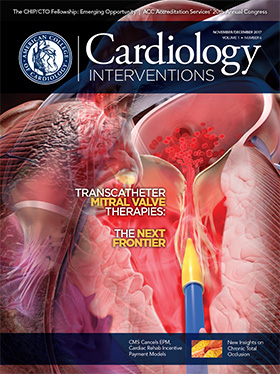JACC in a Flash
Featured topics and Editors’ Picks from all of ACC’s JACC Journals.
DK Crush 2-Stent Technique Superior to Provisional Stenting For LM Bifurcation Lesions

The double kissing (DK) crush 2-stent technique is superior to provisional stenting (PS) for treatment of true distal left main (LM) bifurcation lesions, according to results of the DKCRUSH-V trial, presented at TCT 2017 and published in the Journal of the American College of Cardiology.
Shao-Liang Chen, MD, FACC, et al., compared outcomes in 482 patients with true distal LM bifurcation lesions randomized to treatment with DK crush (n = 240) or PS (n = 242). The patients were followed-up with coronary angiography at 13 months after the index procedure. The primary endpoint was target lesion failure (TLF), a composite of cardiac death, target vessel myocardial infarction (TVMI) and clinically-driven target lesion revascularization (TLR) at one-year follow-up.
At 30-day follow-up, TLF had occurred in 2.9 percent and 0.4 percent of the PS and DK crush groups, respectively (p = 0.03). At one year, TLF occurred in 10.7 percent and 5.0 percent of the PS and DK Crush groups (p = 0.02). Read More >>>
Patients in the DK crush group had lower one-year rates of TVMI and stent thrombosis. Peri-procedural biomarker release was observed in 4.1 percent of PS patients vs. 11.3 percent of DK crush patients (p = 0.004). No significant difference in peri-procedural MI rates was see between the groups (0 percent and 1.2 percent in the PS and DK crush groups; p = 0.33).
According to the authors, “a planned DK crush 2-stent strategy reduced TLF at 1 year compared with a PS strategy in patients with true distal LM bifurcation lesions.”
In a related editorial, Emmanouil Brilakis, MD, PhD, FACC, et al., wrote that DKCRUSH-V “provides the best evidence to date on treatment of [unprotected] ULM bifurcation lesions, showing that DK crush is superior to provisional stenting.” They write the trial established DK crush as the third strategy for ULM stenting. “DK crush is a perfect illustration of the ‘no pain, no gain’ concept: doing DK crush in ULM bifurcation lesions will be more challenging than provisional stenting but will benefit the patients, which is what matters the most,” they conclude.
Chen S-L, Han Y, Zhang J-J, et al. J Am Coll Cardiol 2017;Oct 30:[Epub ahead of print].
EXCEL: QoL Substudy Reports PCI, CABG Yield Similar Outcomes in Unprotected Left Main Disease
A prospective quality of life (QoL) substudy of EXCEL has shown that over 36 months both PCI and CABG were associated with significant improvements in QoL compared with baseline. The results were presented by Suzanne J. Baron, MD, MSC, at TCT 2017 and published in the Journal of the American College of Cardiology.
The previously reported main results from EXCEL showed that rates of death, stroke and myocardial infarction (MI) were similar at 36 months with revascularization with the second-generation everolimus-eluting stent XIENCE or CABG in patients with unprotected left main coronary artery disease (LMCAD) and a SYNTAX score ≤32. However, EXCEL also showed that patients who underwent CABG were more likely to experience an MI within the first 30 days and that patients who underwent PCI had a significantly higher rate of revascularization by 36 months.
Of the 1,905 patients randomized in the international, multicenter study, 1,788 participated in the QoL substudy, conducted to understand whether other factors, including patient-reported health status, should be considered when selecting the revascularization strategy for LMCAD.
Assessments were made at baseline and one, 12 and 36 months using five different tools. Read More >>>
The results showed that an early difference at one month favoring PCI was attenuated by 12 months and at 36 months there was no significant difference between PCI and CABG for QoL. The clinical outcomes at 36 months showed no significant differences in rates of cardiovascular mortality, all-cause mortality, MI or stroke with PCI or CABG. But with PCI there was a higher rate of ischemia-driven revascularization than with CABG (12.6 percent vs. 7.2 percent; p < 0.01).
According to Baron et al., this is the first study to compare the effects of PCI with a contemporary drug-eluting stent (DES) against CABG on patient-reported outcomes in the setting of LMCAD. They note the FREEDOM and SYNTAX trials, conducted with first-generation DES, showed CABG resulted in slightly better long-term angina relief than PCI.
The results showed that an early difference at one month favoring PCI was attenuated by 12 months and at 36 months there was no significant difference between PCI and CABG for QoL.
The investigators offer several potential explanations for the differences in long-term health status outcomes between PCI and CABG observed in the QoL substudy of EXCEL: 1) despite a higher rate of repeat revascularization with PCI than CABG in EXCEL, this difference was substantially lower than in the FREEDOM and SYNTAX trials; 2) exclusion of anatomically complex disease from EXCEL; and 3) shorter duration of the EXCEL substudy (three years) than FREEDOM and SYNTAX substudies (five years).
No meaningful difference was seen by subgroups for the effect of revascularization strategy on health status. In contrast to previous studies, EXCEL showed no significant interaction between the extent of angina relief with either strategy and either the SYNTAX score or baseline angina frequency.
Among patients with LMCAD with low or intermediate disease complexity, the authors conclude that, “Taken together with the three-year clinical data from EXCEL, these results suggest that PCI and CABG provide comparable intermediate-term outcomes for appropriately selected patients with LMCAD.”
Baron SJ, Chinnakondepalli K, Magnuson EA, et al. J Am Coll Cardiol 2017;Oct 30:[Epub ahead of print].
Comparable Stroke Reduction and Less Major Bleeding with LAAC Versus Warfarin in Nonvalvular AFib

Left atrial appendage closure (LAAC) with the Watchman device prevents stroke in patients with nonvalvular atrial fibrillation (AFib) comparable with warfarin, with reduced major bleeding and mortality, according to the five-year results of the PREVAIL and PROTECT-AF trials, presented at TCT 2017 and published in the Journal of the American College of Cardiology.
Vivek Y. Reddy, MD, et al., reported the final, five-year results of PREVAIL, both alone and as part of a patient-level meta-analysis with PROTECT-AF five-year data. In the two trials combined, 1,114 patients with nonvalvular AFib were randomized to LAAC with the Watchman device (n = 732) or warfarin (n = 382) for 4,343 patient-years. The first primary efficacy endpoint in PREVAIL was the same as the primary endpoint in PROTECT-AF – the composite of stroke, systemic embolism or cardiovascular/unexplained death. In PREVAIL, the second primary efficacy endpoint was the composite of ischemic stroke or systemic embolism after seven days post randomization. The event rates were calculated as events per 100 patient-years. Read More >>>
In PREVAIL, the first primary endpoint did not achieve noninferiority of the device to warfarin, with a calculated 18-month rate of 0.066 for LAAC compared with 0.051 for warfarin. The second primary endpoint did achieve noninferiority, with a calculated 18-month rate of 0.0255 for LAAC vs. 0.0135 for warfarin.
In the meta-analysis, the rates of the composite of stroke, systemic embolism or cardiovascular/unexplained death were similar between groups (p = 0.27). The rates of all stroke or systemic embolism were also similar (p = 0.87). However, there was a large significant reduction in hemorrhagic stroke with LAAC vs. warfarin (hazard ratio, 0.20; p = 0.0022). With LAAC, there were significantly fewer disabling or fatal strokes (p = 0.027) and significantly lower rates of cardiovascular or unexplained death (p = 0.027). LAAC was also superior with respect to all-cause death (p = 0.035) and major bleeding (p = 0.0003).
Limitations of PREVAIL that might explain the failure of the first primary endpoint to achieve noninferiority include the lack of statistical power and the unusually low ischemic stroke rate (0.73 percent) in the warfarin group due to small sample size.
The five-year outcomes of PREVAIL and PROTECT-AF demonstrate that LAAC with the Watchman device provides similar stroke prevention as anticoagulation in patients with nonvalvular AFib. According to the authors, “the primary benefit of LAAC is the ability to avoid oral anticoagulation (OAC) and its associated bleeding risk… By minimizing major bleeding, particularly hemorrhagic stroke, LAAC results in less disability or death than warfarin.” “For patients who are poor candidates for long-term oral anticoagulation, LAAC is a reasonable strategy for stroke prophylaxis,” they conclude.
In a related editorial, Jacqueline Saw, MD, FACC, comments, “Although the consummate clinical trialist would demand a more robust study methodology, it is reasonable to accept the available data from PREVAIL despite these potential flaws.”
According to Saw, the patient-level meta-analysis of PROTECT-AF and PREVAIL provides additional data that helps address the limitations of PREVAIL. “Reductions of cardiovascular and all-cause mortality is a remarkable feat with this device therapy, and emphasizes one of the key benefits with LAAC, which is reduction of major bleeding and associated complications with lifelong OAC administration,” she concludes.
Reddy VY, Doshi S, Kar SL, et al. J Am Coll Cardiol 2017;Nov 2:[Epub ahead of print].
IVC Filters Appear Safe, Effective For PE in Meta-Analysis; Questions Remain

Inferior vena cava (IVC) filters appear to reduce the risk of subsequent, increase the risk for deep vein thrombosis and have no significant effect on overall mortality, according to research published in the Journal of the American College of Cardiology.
In this systematic review and meta-analysis Behnood Bikdeli, MD, et al., examined 11 studies with a total of 4,204 patients on the efficacy and safety of IVC filters. Use of IVC filters was associated with a reduced risk of subsequent pulmonary embolism (odds ratio [OR], 0.50). Mortality related to pulmonary embolism was nonsignificantly lower in patients who had an IVC filter compared with controls (OR, 0.51). Use of IVC filters was not associated with a significant change in all-cause mortality (OR, 0.91). Compared with controls, patients receiving an IVC filter had an increased risk of subsequent deep vein thrombosis (OR, 1.70). Read More >>>
The five randomized controlled trials (RCTs) included in the meta-analysis all had limitations in methodology and in outcomes assessment. All were open label, and blinded outcome assessment was reported in only one trial. One study had a high risk of bias for lack of random sequence generation. Confidence in the outcomes estimates derived from pooled data from the RCTs for all outcomes was low.
The authors acknowledge that the small number of studies and patients included is a limitation and express the hope this study will lead to larger prospective controlled studies to better inform the evidence base across clinical scenarios. Until then, practitioners should be mindful about indiscriminate use of IVC filters.
In an accompanying editorial, Stavros V. Konstantinides, MD, PhD, writes that this study, “reminds us to avoid the indiscriminate use of filters (as well as any other interventions) in patients for whom excellent medical therapy is available. It also highlights the importance of documenting, in prospective cohort studies fulfilling high methodological standards to exclude selection and reporting bias, the characteristics and the outcomes of patients receiving inferior vena cava filters for prevention of pulmonary embolism.”
Bikdeli B, Chatterjee S, Desai NR, et al. J Am Coll Cardiol 2017:70:1587-97.
Keywords: ACC Publications, Cardiology Interventions, Angina Pectoris, Atrial Appendage, Atrial Fibrillation, Biomarkers, Coronary Angiography, Coronary Artery Disease, Drug-Eluting Stents, Embolism, Follow-Up Studies, Hemorrhage, Myocardial Infarction, Odds Ratio, Outcome Assessment, Health Care, Outcome and Process Assessment, Health Care, Prospective Studies, Pulmonary Embolism, Quality of Life, Random Allocation, Research Personnel, Risk, Sample Size, Stents, Stroke, Thrombosis, Vena Cava Filters, Vena Cava, Inferior, Venous Thrombosis, Warfarin
< Back to Listings

